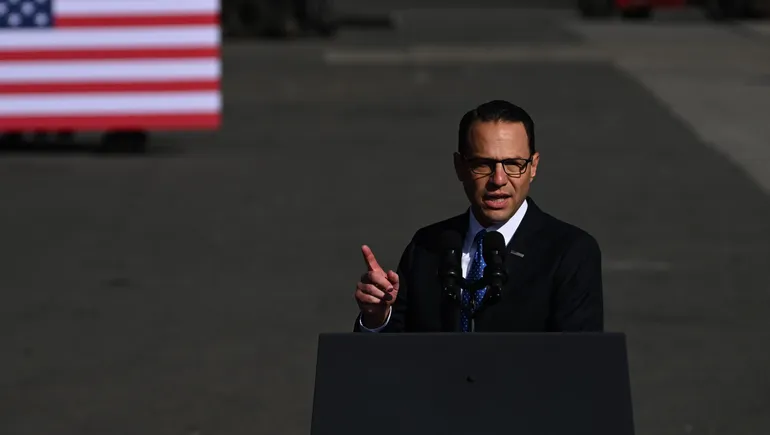Pennsylvania spent less per capita on higher education than almost any other state in fiscal 2024, according to preliminary data from the State Higher Education Executive Officers Association.
It’s a statistic that’s come up often in Pennsylvania recently, as the governor and state lawmakers try to invest in — and potentially revamp — the commonwealth’s higher education landscape.
Two Democratic lawmakers introduced a proposal in the commonwealth’s Senate and House last week intended to carry out Gov. Josh Shapiro’s new vision for higher education, including plans meant to make higher education more affordable for students.
The bills would also create a new statewide higher education board. However, the bills do not have language mentioning one of Shapiro’s earlier proposals — unveiled in January — to unite the state’s public university system and community colleges.
Meanwhile, state Senate Republicans, who control the chamber, have answered with a bill package of their own. Because the state’s Legislature is divided, Republicans and Democrats will likely have to compromise to pass any actual legislation.
“We put forth a blueprint. We listened to the people across Pennsylvania,” the governor said at a press conference Tuesday. “We listened to Republicans and Democrats in the House and Senate. They’ve now put some ideas forward and there’s some good stuff in there.”
What does the governor want?
The twin bills from the Democratic lawmakers have three primary objectives.
The hallmark of the plan is to create a statewide higher education board to improve coordination among Pennsylvania’s colleges, including by recommending academic programs, tuition and fees, and student financial aid policies.
The commonwealth has no overarching higher education system, with 15 community colleges each operating independently and outside of the state’s university system, called Pennsylvania State System of Higher Education, or PASSHE. The system enrolls over 82,000 students across 10 universities.
That’s not to mention what are called the state-related institutions — Lincoln University, Pennsylvania State University, Temple University, and University of Pittsburgh — public institutions that operate largely independently but receive some state money.
The legislation would transfer some of the powers of the State Board of Education and the Council of Higher Education to the new 15-member board.
Through a last-dollar grant program, the state would also cap tuition at $1,000 at PASSHE institutions and community colleges for students whose families earn up to around $70,000 annually. And it would distribute state appropriations to colleges by an outcomes-based funding formula.
Opposition against Shapiro’s initial pitch
The governor’s original proposal — which specifically called for uniting the state’s university system and community colleges under one system — drew detractors.
Blake Eisenhart, a trustee of Bucks County Community College, argued in a March op-ed for the Reading Eagle that the plan would have created a “cumbersome statewide bureaucracy that could well stifle innovation, preclude agility, and hinder progress.”
“Pennsylvania only has 15 community colleges. They are locally sponsored and controlled, and most overachieve in their communities because they are singularly focused on local market needs,” Eisenhart wrote at the time. “Systemization will erode these local achievements and capabilities.”
Some state Republicans had also questioned the wisdom of the consolidation plan, saying it would create further bureaucracy and doesn’t address enrollment challenges.
“The governor’s proposal is not ready for prime time,” said Sen. Joe Pittman, the chamber’s majority leader, at a press conference on April 10. “He wanted to take one entity that was losing 37% enrollment, another that lost 30% enrollment, bring them together without any apparent decisions on right-sizing them or making them more efficient.”
Indeed, enrollment declined around 30% at PASSHE from fall 2010 to fall 2023. Enrollment at the state’s community colleges dropped 25% from fall 2017 to fall 2021, declining to about 89,000 students.
The Shapiro administration held more than 200 meetings with stakeholders and legislators since January to design its final plan: a state board of education that would allow more coordination, but some local control.
What do Senate Republicans want?
The plan Republicans introduced in April, a package of bills entitled Grow PA, is mostly aimed at boosting enrollment at the state institutions, especially in high-demand fields.
One proposed scholarship program in the Republican plan would offer grants of up to $5,000 for Pennsylvania residents who study an in-demand field in the state — such as teaching, healthcare or law enforcement — and agree to live in the state after graduation.
For each year they receive the grant, students would need to live in Pennsylvania for 15 months post-graduation, meaning five years total for four years of college. Another bill would extend similar grants to eligible out-of-state students. In both cases, the grants would become loans for students who move out of the state before the required time.
Pennsylvania’s Senate this week passed both of those bills with bipartisan support.
“We’re not going to be able to help every college student in every discipline,” Sen. Dave Argall, the Republican chair of the chamber’s education committee, said in an interview in May. “What we’re trying to do is focus like a laser beam on where we need to encourage students to study.”
Other bills in the Republican package would expand existing scholarship programs, add performance-based funding metrics to the state-related institutions, and make completion of the federal financial aid application a high school graduation requirement. These were also approved by the Senate.
Wil Del Pilar, who served as Pennsylvania deputy secretary of postsecondary and higher education from 2015 to 2017, said parts of the Republican plan sound like good ideas, such as the federal financial aid application requirement and investments in dual enrollment. But he has concerns about other provisions, including the residency requirement for scholarships.
“If you want an equitable plan, don’t do this,” said Del Pilar, who now works at The Education Trust. “If there isn’t employment where the student is living then the graduate should go where there is employment.” And when these types of grants do become loans, they can be difficult for states to collect on.
Shapiro, meanwhile, is encouraged that Senate Republicans are looking to take action to change the higher education system, he said.
“People in both chambers, in both parties acknowledge the fact that we’ve got to do something meaningful on higher ed and so I appreciate the Senate’s movement on that,” the governor said Tuesday. “We’re going to continue to work together to make progress on higher ed.”
#dueling #visions #future #Pennsylvanias #higher #education










